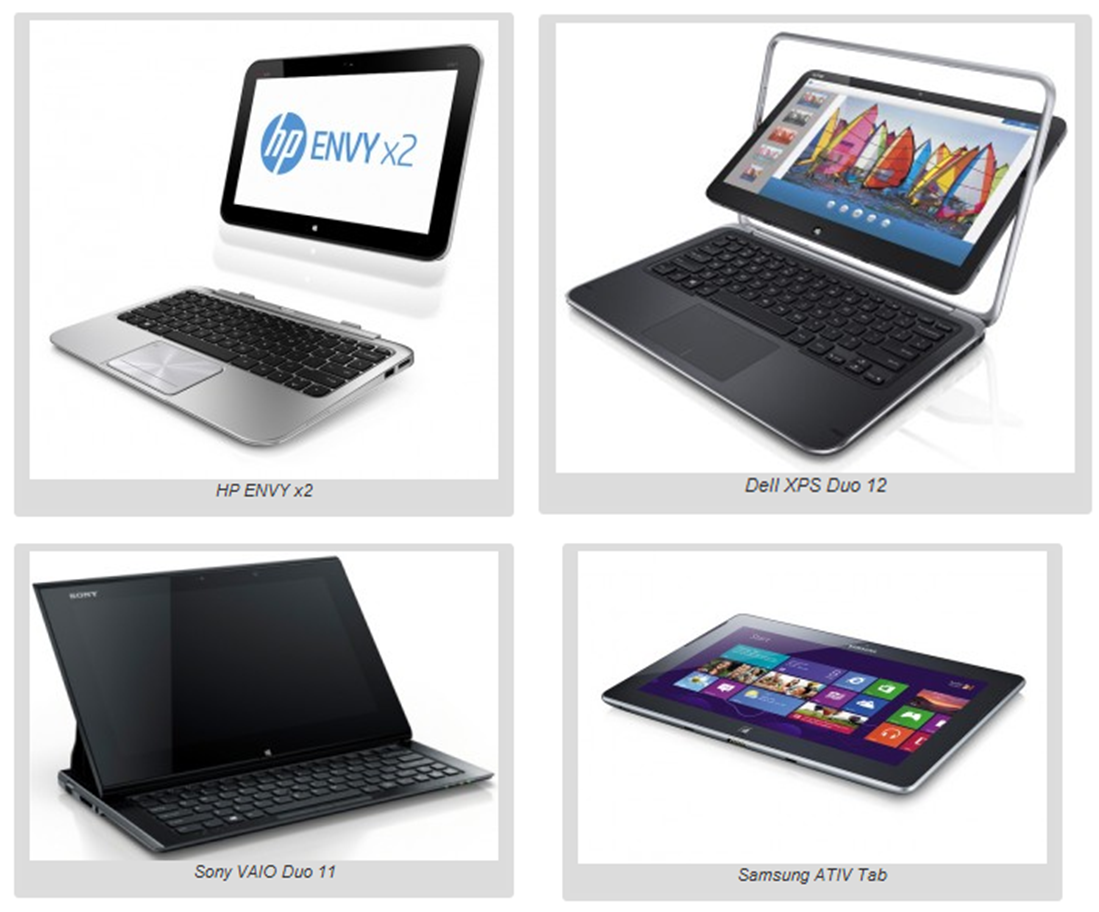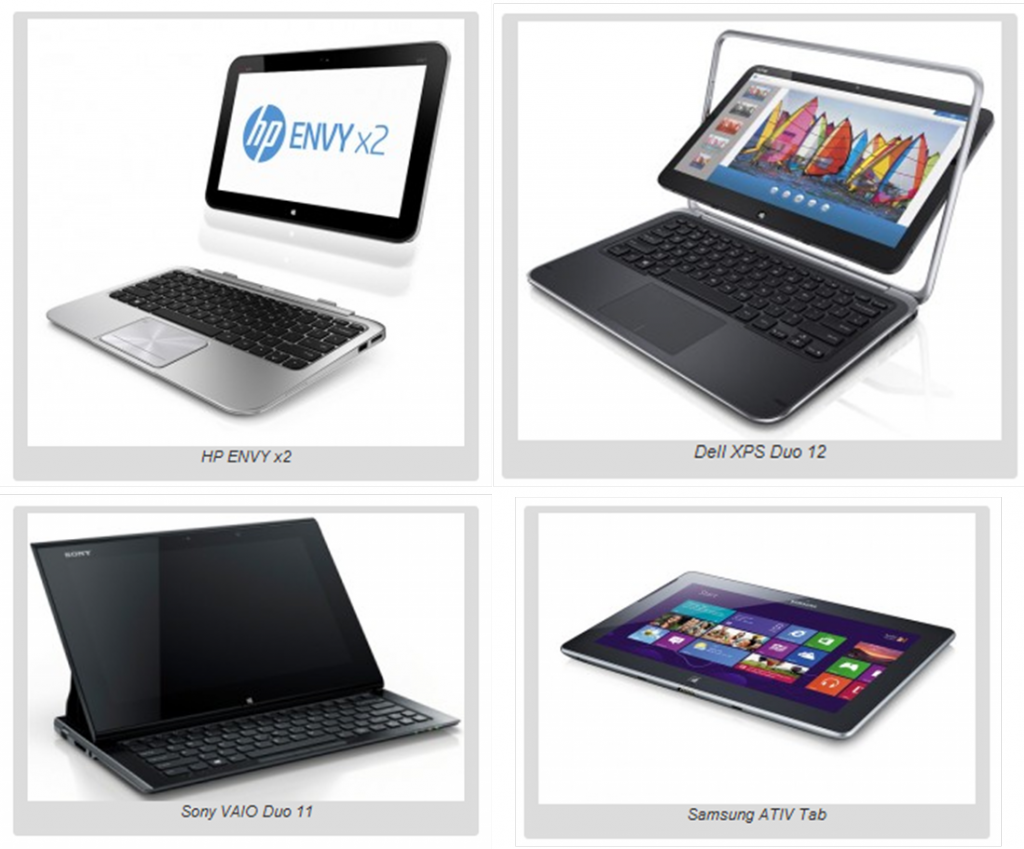Last week at IFA in Berlin, Germany, HP, Dell, Samsung, and Sony announced some very unique hardware designs for Windows 8. They included touch notebooks, convertibles, sliders, flippers, hybrids, and tablets that can take advantage of Microsoft’s Metro touch-based UI. The hardware was very impressive and it was obvious that a lot of thought and effort went into the design. Will these be successful? It’s impossible to say at this point because two huge questions have yet to be answered: device price and the number of high quality Metro applications. Device prices will be announced by Windows 8 launch on October 26, but I want to dive into the applications question. Without many high-quality Metro-based application details on the horizon, it’s hard to get excited about the hardware.
Let’s first look at the diversity of products.
Touch-based Hardware for Windows 8
There were many innovative devices launched at IFA to take advantage of Windows 8 touch for the Metro environment. Here are a few that appeared innovative:
- HP SpectreXT TouchSmart– Premium 15.6″ HD touch display Ultrabook with Intel Thunderbolt technology.
- HP ENVY x2– Ultrathin notebook whose 11.6″ HD display can be removed and used as a tablet.
- Dell XPS Duo12– Premium Ultrabook with 12″ touch whose screen flips around to be used as a tablet while in Metro-mode. The design includes use of machined aluminum, carbon fiber, and Gorilla Glass.
- Dell XPS One 27– Premium All In One with a 10-point touch enabled, Quad HD (2560×1440) 27″ display. The all in one will lay flat as well, enabling multiple users to use it at the same time.
- Sony VAIO Duo 11– Slider with an 11″ display that operates as a notebook and a tablet when the HD display is slid onto the keyboard.
- Samsung ATIV Tab– Windows RT tablet with 10″ touch display. It’s thin at 8.9 mm and light at 570 grams
As you can see, the diversity of Windows 8-based touch devices was very wide, which, given a wide variety of high quality apps, would usually mean that something would stick. The problem is, few really know the true state of Metro-based touch apps, including most PC and chip makers.
Ecosystem Losing Confidence in Metro Application Delivery Timing
Nearly ten months ago, Microsoft held its BUILD conference for Windows 8 software and hardware ecosystem partners. Microsoft also launched their development platform for Windows 8, called Visual Studio 11. Every attendee went home with a robust Samsung developer tablet and keyboard with Visual Studio Express Beta, intended to spur development of Metro-based applications. As of April 2012, six months later, 99 applications were available. As I outlined here, this was way behind where Apple was but far ahead of where Android was.
So where does that leave the state of Metro apps? Microsoft is now seven weeks away from launch and virtually no one has much of a sense for how many compelling Metro apps will be available at launch. Here were some key milestones that Microsoft has anounced:
- April 18, announces developer submission locales from 5 to 38 markets, but limited to select partners; app catalog at 21 markets
- May 31, “hundreds of preview apps in the catalog-including the first desktop app listings”; app catalog increases to 25 markets; Share contract added
- July 20, Microsoft outlines how to monetize and get paid for apps
- August 1, RTM Windows store opens; “qualifying businesses can submit apps”; 54 new markets and 24 app languages added
As of today with my version of Windoes RTM, I can only see 844 Desktop + Metro apps in the Windows 8 store. I do not see most of my favorite apps, including Facebook, Path, LinkedIn, Pinterest, Google+, Netflix, Hulu+, Amazon Video, HBO Go, ESPN Video, Time Warner Video, CNN, Flipboard, Pulse, Nike Running, MyFitnessPal, Pandora, Flixter, or E*trade. I am concerned and many ecosystem executives are telling me that they are very concerned with the state of Metro-based applications. Should we really care about how many Metro applications will be available at launch given Windows 8 is a five year investment?
Why Should We Care About Apps at Launch?
Having microscopically observed and participated in the launch of the Motorola XOOM, HP TouchPad and the BlackBerry PlayBook, there were some common threads that led to their failed launches and quick retreat. These issues included:
- Incomplete hardware: hardware features did not work or were not available, including SD cards, and LTE support.
- Incomplete paid content: lack of support for paid movies, music, games and books.
- Sluggish and buggy: experience was slower than expected and/or included many bugs
- Lack of high quality apps: few applications were available that consumers recognized or were compelling. In some cases, basic apps were missing like calendar, mail and contacts.
- Priced at iPad: tablets even with issues above were priced on top of the iPad, an already known and successful product with a great consumer brand
Many of these issues were addressed shortly after launch, but it didn’t make a difference. The damage was done and in most cases, irreparable. What developer wants to write apps for an ecosystem or platform that just got slaughtered by the press, analysts and consumers?
What about post-launch? Some issues still exist even for 10″ Android tablets. Android 10″ tablets have come a long way with ICS, Jelly Bean and paid content, but still suffer from a lack of high quality apps, which still number in the 100’s. Remember, part of the the success of the Google Nexus is that it leverages the Android phone applications, not those designed for tablets. And, let’s not forget it is priced at half of the iPad. I believe Windows 8 will launch with #1 complete hardware via PC makers, #2 paid content via XBOX Live, Netflix and Kindle and so far it looks that even #3 Windows RT will have acceptable performance. As for #4 and #5, well no one know yet and if we can learn anything from Android tablets, a robust supply of touch-based applications are required for success, which eludes them almost 2 years later.
I’ll say it again…… innovative consumer hardware for touch-based products is meaningless without thousands of high quality, compelling and popular apps.


— Windows RT has no tablet apps.
— Windows pro is trying to run desktop apps on a tablet form factor.
— Windows Surface is a tablet meant to be used as a notebook.
— Windows 8 on the desktop is a desktop operating system that tries to emulate a tablet interface.
Microsoft claims that Windows 8 has no compromises. So far, it looks like Windows 8 is nothing BUT compromises.
I just feel like Microsoft, having allowed themselves to be so late getting into tablets, is really pushing hard trying to catch up; and the inevitable result is going to be hardware and software products released with lots of glitches and missing (or weird) features. The only question seems to be how will the market respond? It’s a pretty interesting question.
Yes, trying to catch up is going to lead to glitches.
But I think the more important reason that Windows 8 looks the way it does is that, in order to survive in mobile, Microsoft NEEDS to migrate its Window developers from the desktop to the mobile space.
To encourage that, Microsoft is a) calling everything “Windows” and pretending that it’s all its iterations are actually just one giant monolithic operating system, and b) denying that there is a divide between touch and mouse and insisting that touch can simply be added on top of a mouse driven interface – and vice versa.
The problem is that potential developers are looking at the Windows 8 dual user interface, the dual CPU offerings, the apparent need for a keyboard/stylus, inferior touch capabilities, etc. and thinking WTF?
One additional comment regarding possible developer reservations.
My company has developed, sold and “Supported” (with a capital S) Windows applications for over 17 years. The reason I highlight the word Support is because Support is a major activity for any company who develops and sells applications. A material part of support, at least in our case, is devoted to the operating system. Clients will call you with questions about the OS and even if you may view this as “not my job”, the client doesn’t see it that way. To the client, it is one system and many times cannot distinguish between what is your job and someone else’s. Therefore if Windows 8 is as confusing as some believe, it could really impact the effort in a developer’s ability to supply support, in a very negative way.
So as a developer, when I look at Windows 8, I would be very cautious about developing for it. I would definitely wait and see if my concerns were real.
I don’t see a lot of Windows developers wanting to spend resources on Metro apps initially. It is logical to develop for the biggest market which means something that can run on Vista, 7 and 8, which means desktop. Windows 8 will be deployed in vastly greater numbers on non-touch desktops than tablets and so the dominant access method for most users will be mouse and keyboard. Plus there is no need to make guesses about the popularity of Windows tablets or piracy levels on those tablets when trying to predict revenue.
A Metro app might be nice for a developer to have in the bag, but I think that will be an afterthought or at best a complementary product for the desktop app (see Cyberlink’s Power Director). I just can’t see how there will be significant investment in Metro apps unless Windows RT tablets sell in large volumes, which seems unlikely if there aren’t the apps , also you just know version 1 of Windows on ARM is going to be very buggy.
Rather oddly if Windows 8 pro tablets sell in much greater numbers than RT, there will be even less incentive to develop Metro apps which again makes Windows 8 such a confused mess of a product. They should have just bought WebOs and ported Office. That operating system was brilliant on a tablet.
Thank you for great content. I look forward to the continuation.
Pretty! This has been a really wonderful post. Many thanks for providing these details.
Very well presented. Every quote was awesome and thanks for sharing the content. Keep sharing and keep motivating others.
Muchas gracias. ?Como puedo iniciar sesion?
Immerse yourself in pixels: Where every click leads to glory. Lucky Cola